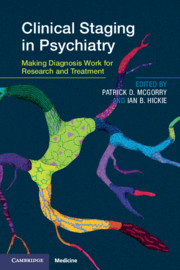Book contents
- Clinical Staging in Psychiatry
- Clinical Staging in Psychiatry
- Copyright page
- Contents
- Contributors
- Foreword
- Acknowledgements
- Section 1 Conceptual and Strategic Issues
- Section 2 Progress with Clinical Staging
- Section 3 Novel Treatment Strategies
- Section 4 Novel Treatment Strategies
- Index
- Plate Section (PDF Only)
- References
Section 1 - Conceptual and Strategic Issues
Published online by Cambridge University Press: 08 August 2019
- Clinical Staging in Psychiatry
- Clinical Staging in Psychiatry
- Copyright page
- Contents
- Contributors
- Foreword
- Acknowledgements
- Section 1 Conceptual and Strategic Issues
- Section 2 Progress with Clinical Staging
- Section 3 Novel Treatment Strategies
- Section 4 Novel Treatment Strategies
- Index
- Plate Section (PDF Only)
- References
Summary
A fundamental aim of diagnosis is to guide treatment planning and predict illness course. Yet for too long psychiatric diagnosis, grounded on traditional silo-based approaches, has lacked clinical utility. This chapter explores the purpose of diagnosis and classification as well as the inability to validate diagnosis in psychiatry. It is proposed that new testable models are needed to improve the utility of diagnosis and support more personalised and sequential treatment selection. A number of new approaches have been put forward, including hierarchical and network-based methods, however at present, these offer limited value in guiding treatment selection. Clinical staging offers a viable solution. Clinical staging in psychiatry recognises that mental disorders are not static and discretely defined entities, but rather they are syndromes that overlap and develop in stages. The model ensures that interventions are proportional to both need and the risk of progressing to later stages and more established syndromes, which are likely to be comorbid, persistent, recurrent and disabling. Ultimately, it advocates a transdiagnostic approach to intervention, with a pre-emptive focus, that is based on risk-benefit considerations and patient needs. Clinical staging also provides a framework in which underlying biological mechanisms can be linked to each stage, to build a personalised and pre-emptive psychiatry.
Keywords
- Type
- Chapter
- Information
- Clinical Staging in PsychiatryMaking Diagnosis Work for Research and Treatment, pp. 1 - 80Publisher: Cambridge University PressPrint publication year: 2019

